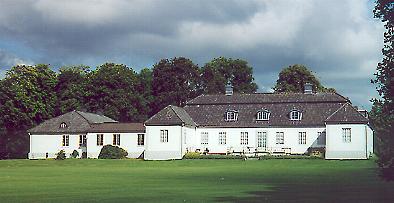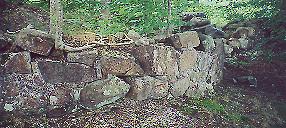

The following has been translated from the Swedish by Mary Seeger one of our many benefactors in this undertaking. The text and the pictures are from the web page <http://www.algonet.se/~sylve_a/rossjohm.htm>. There is every reason to believe that Charles Ludwig Fredrickson was born and raised on the estate Rossjoholm. Several of W. A. Fredriksson's letters were addressed from Rossjoholm and he makes reference in one of them to the fact that "the old barronen...... is dead". The timeframe would coincide with the passing in 1892 of the then-owner of Rossjoholm, Christian Rosenorn-Lehn.
The name, Rossjoholm, is an example of the Swedish language practice (shared with all other Germanic languages) of forming words and names by the combination of other words. Ros means cairn, a border or pile of stones. Sjo is lake, and holm is island.

Rossjoholm lies on the southern shore of Ros Lake on the edge of the wooded Hallands ridge, barely a (Swedish) mile west-northwest of Orkelljunga. The estate is in a very lovely location, according to the Swedish botanist, Linneus, so lovely that no painter can imitate its beauty.
The estate has not always been in this location. According to old documents, in oldest times, it is supposed to have been at one end of the nearby Vaster Lake then have moved to a point in Kyrk Lake south of Ros Lake. From there the estate moved again when Karen Geed in 1553 had built a fortification not far from the present Ros Lake, said to have consisted of four three-story buildings with foundation walls with seven towers within a high stone wall, and with a drawbridge between the island and the mainland. The fortress was demolished by marauders during the Scanian War in the 1670's, but the ruins can still be seen on the island in Ros Lake. A new estate was built in 1696 further inland on the place where it is today. This estate too underwent a dramatic fate with two successive fires, one of which was caused by the dedication salute. The main building of today with wings is from 1731 and executed in so-called Carolingian baroque style.
The first own owner of Rossjoholm is Oluf Geed, who lived during the later part of the 1400's, but the estate is believed to have been in his family's possession as early as the 1300's. Oluf Geed also owned Gedsholm. In 1470 he took part in the battle of Oresten near the Halland border as commander of the Danish shooters, when Christian I, attempting to penetrate Sweden, was defeated by Sven Sture the Elder. During the battle, Geed took flight, and because of his cowardice was condemned to lose his life, his honor, and his property, but managed to flee once more. His son Jacob Geed later regained Rossjoholm and Gedsholm. He was the last male in the line and his daughter, Karen Geed, inherited both estates and also Jordberga, which her mother, Bodil Hollunger, brought to her marriage.
Through Karen Geed's marriage to Mogens Krabbe of Vegeholm the properties went into his family's possession. Mogens was the son of one of Denmark's most prominent men, the marshall Tyge Krabbe, and owner of Skillinge and Ossjo. He also received Ovesholm as a fiefdom and himself acquired a number of additional estates in Scania. He participated vigorously in the battles of his time and drowned in 1564 at Tofta Bridge in Smaland during a battle between Danes and Swedes. Her marriage to the rich Mogens Krabbe gave wife Karen economic possibilities to build the stately fortification mentioned above on Ros Lake Island. She kept both paternal estates, with Rossjoholm as widow's estate, until her death in 1587. It is reported that she always included in her morning and evening prayers the words: "For my dry and poor Rysselholm, I ask you, O God, for good weather with rain early and often, but for my good little Gedsholm I don't need both, that's enough."
The son Jacob followed her as owner of Rossjoholm and he was followed in 1597 by his brother, Tage Krabbe.1n 1612 the estate was inherited by his son Niels, who also owned Skillinge, Viderora, and Ossjo. He was a prominent man and one of he lords of the land, counsel of the realm, and knight of the Order of the Elephant. He had Laholm and Halmstad as fiefdoms and was the last Danish commander at Halmstad Castle. Afterward he got Kristianopels and Solveborgs land and was governor-general n Blekinge and finally appointed to the land- and general-commission in Skane. He was one of three noblemen who were chosen to deal with the Swedes on the matter of the Scanian compensation for the island of Bornholm. Because he refused to swear loyalty to the Swedish king, his property went to the crown, but he got it back after the peace of 1660. When he died in 1663, he left only daughters as his heirs.
In 1672, they sold Rossjoholm to the Swedish baron Augustin Leijonskold who was the land chief in the Malmo house with many Scanian holdings. During the time of his ownership, the Scanian war raged, that is, the Danish-Swedish War, 1675- 79, during which the marauders with their guerilla tactics caused the Swedes great harm. One of their haunts was the inaccessible Halland ridge. At Trollehallar north of Ros Lake are the so-called Sharpshooters' sheds with steep cliff walls, where the freebooters had their supplies and kept their prisoners. Because they didn't want to have a Swedish stronghold in the neighborhood, they devastated Karen Geed's magnificent castle. Baron Leijonskold died in 1680. His widow, Barbara Veronika Sybilla Moser von Filseck then held the property until her death in 1703 and in 1696 had a new residence built on the site of the current main building.
Her heirs sold Rossjoholm to the prosperous Nils Silfverskiold in 1705. He made a career for himself as a public official, eventually becoming the Governor of Kristiansstads province. After the main building was destroyed by fire in 1730, he had a new one built, ready to e dedicated in 1731. For the dedication, his son Arvid had gotten a couple of cannons in order to entertain the guests with a salute. He aimed the cannons so badly that the shots set fire to the new building, which burned down. The manor house was rebuilt in the same year and has been preserved until our times.
Linneus visited Rossjoholm on his Scanian trip in July 1749. He reports that a soap boiling operation belonged to the estate, located on the west side of Ros Lake. The process involved soaking potash in rectangular reservoirs and having it run down through a hole in the sloping banks. The solution was blended with fat and oil and boiled into green soap in a large iron kettle. On the same spot there was also an oil plant. The stamping mill, warming oven, and even the presses were driven by waterwheels. The raw materials for the factory, the rape seed, was imported from Holland.
Arvid Silverskiold didn't take over Rossjoholm after his parents' death, but his brother Peter did instead. Peter took over the property in 1755 and at the same time left his position as staff captain with the Hamilton regiment. He died in 1799, and, after that his widow and heirs held the property unti1 1803, when his son, the cavalry captain Nils Silfverskiold, took over. At that time the property was in very poor condition. According to contemporary documents, the land was in a decadent state, and there was only one horse in the cattle shed (an Oland pony at that), twelve cows, a bull, and twenty sheep. Nils Silfverskiold was an energetic man and married to Anna Elisabet, daughter of the wealthy foundry proprietor Olof Strom. In the barely twelve years up to his death in 1815, he got the property into good condition with new fields, repairs, and new construction.
In 1819 his widow sold Rossjoholm to the land counsel Cornelius Alexander Sjocrona. The property changed hands numerous times, with large portions being sold off to cover speculation costs.Finally the property was bought by the Danish land barons Christian and Erik Rosenorn-Lehn and has remained in that family since then. Christian became the sole owner in 1860, and was succeeded in 1892 by his son Fredrik Marcus, whose son Carl Fredrik took over the property in 1935. Since 1969, Rossjoholm, with holdings of 2600 hectars (6400 acres), has been owned by his son Fritz Rosenorn- Lehn.
In the administrator's home on the property the author Frans G. Bengtsson was born in 1894. He wrote among other things the juicy novels about the Viking Red Orm, and in "Den lustard jag minns" (the summerhouse I remember) he describes his childhood at Rossjoholm.
The ruins of Karen Geed's castle can be reached via a footbridge, and are open to the public every Sunday in the summer.
